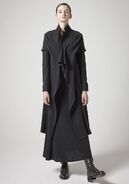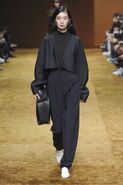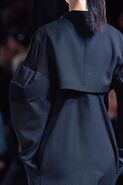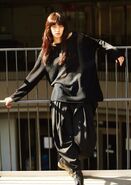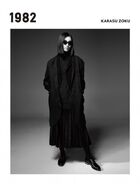mNo edit summary Tag: Visual edit |
m (Fixed spelling) Tag: Visual edit |
||
| (15 intermediate revisions by 4 users not shown) | |||
| Line 1: | Line 1: | ||
| − | {{Aesthetic|title1 = Karasu Zoku|image1 = Karasu zoku.jpg|other_names = Crow tribe|decade_of_origin = 1982-1990s|creator/s = Yohji Yamamoto and Rei Kawakubo|key_colours = only black}}'''Karasu Zoku''' was a japanese movement during the 1980s that consisted of wearing all-black designer outfits. While similar fashion trends are still around, the term is no longer used due to the |
+ | {{Aesthetic|title1 = Karasu Zoku|image1 = Karasu zoku.jpg|other_names = Crow tribe|decade_of_origin = 1982-1990s|creator/s = Yohji Yamamoto and Rei Kawakubo|key_colours = only black|caption1=|key_motifs=darkness, mystery, unpredictability|key_values=rejection, emancipation|related_aesthetics=[[Black]]<br>[[Dark Paradise]]|related_media=|related_brands=}}'''Karasu Zoku''' was a japanese movement during the 1980s that consisted of wearing all-black designer outfits. While similar fashion trends are still around, the term is no longer used due to the base association with violent gangs around the height of its popularity. |
| ⚫ | |||
| − | Rei Kawakubo and Yohji Yamamoto presented their works at the Paris Collection in the spring and summer of 1982, giving the fashion world a “black impact”. |
||
| ⚫ | |||
| ⚫ | |||
| − | In addition, DC brands such as "Comsade Mode" and "Scoop", which were popular at that time, also promoted black fashion. |
||
| ⚫ | Rei Kawakubo and Yohji Yamamoto presented their works at the Paris Collection in the spring and summer of 1982, giving the fashion world a “black impact”. It was evaluated by current Chanel and Fendi designers Karl Lagerfeld, Jean Paul Gaultier, and Donna Karan, and gradually passed on to the media, entertainers, artists, and the cutting-edge people of the era. In addition, DC brands such as "Comsade Mode" and "Scoop", which were popular at that time, also promoted black fashion. |
||
Not only Harajuku and Shibuya, but also the adult town of Ginza was crowded with Karasu Zoku. |
Not only Harajuku and Shibuya, but also the adult town of Ginza was crowded with Karasu Zoku. |
||
| + | === Issues with Nebuta Matsuri === |
||
| + | They enter the festival wearing black costumes instead of the traditional ''haneto'' costumes, leading to the nickname "crow gang" or simply, "crows." They're also known as "crow ''haneto''," but their appearance and actions are not fitting of the name ''haneto'', and the regional media does not include the word in their descriptions. They are classified as a type of foot-borne bōsōzoku. |
||
| + | The ''karasu-zoku'' first appeared at the festival in 1986. Initially, they were not viewed as a serious problem, but they became more dangerous when bōsōzoku members began joining. The Japanese started raising awareness about this issue, but it only made Karasu Zoku more popular. |
||
| + | Aomori City quickly took steps to ensure the safety of their festival, as it was a well known tourist attraction. In 1996, the organizers forcefully grouped the ''karasu-zoku'' together into a single area in order to monitor their actions more effectively. However, this only led to an increased level of hysteria among the gang members and was not an effective method of containing their behavior. The number of Crow Gang increased to over 10,000 by 2000, and their actions escalated to violence against different gang members or even against tourists and the police force, which destroyed the festival cheer and decreased public safety. |
||
| ⚫ | |||
| − | Karasu Zoku consists of covering the whole body in only black. |
||
| + | In 2001, the organizers introduced a system where all of the floats would begin and end their procession at the same time. The same year, the prefecture enacted a law that allowed the police force to act against the vandals before the violence began. As a result, the festivities became more contained, but the number of crow gang members decreased drastically. |
||
| − | It was also popular to wear it in a heavy layered style by combining long lengths and tattered details. |
||
| ⚫ | |||
| + | Karasu Zoku consists of covering the whole body in only black. It was also popular to wear it in a heavy layered style by combining long lengths and tattered details. The name comes from the appearance of a group of black crows. The style is androgynous, asymmetrical, and utterly unpredictable in shape[[File:カラス族メイク&くまみきが原宿系になるまで The Karasu-zoku Make-up & How Kumamiki Became a Harajuku Girl|right|thumb|150x150px]] |
||
| + | *Deep V-necks |
||
| − | The name comes from the appearance of a group of black crows. |
||
| + | * Long, saggy skirts |
||
| + | * Wrinkled fabrics |
||
| + | * Slashed sleeves |
||
| + | * Belts |
||
| + | * Scarves |
||
| + | * Collared capes |
||
| + | * Bustled skirts |
||
| + | * Heavy pants |
||
| + | * Turtlenecks |
||
| + | * Choppy haircuts |
||
== Fashion == |
== Fashion == |
||
Not only black-based designer brands, but also DC brands, which are casual and easy to wear trends, were also popular. |
Not only black-based designer brands, but also DC brands, which are casual and easy to wear trends, were also popular. |
||
| − | '''Brands''' |
+ | '''Popular Brands:''' |
| − | * Comme des |
+ | * Comme des Garçons |
* Yohji Yamamoto |
* Yohji Yamamoto |
||
| + | *Issey Miyake |
||
| ⚫ | |||
| + | *Yves Saint Laurent |
||
| ⚫ | |||
| + | *Dior Homme |
||
| + | *Saint Laurent Paris |
||
| ⚫ | |||
| ⚫ | |||
| + | == Gallery == |
||
| + | <gallery orientation="none" widths="185"> |
||
| + | All Black in a new trend.jpg |
||
| + | All Black Harajuku Minimalist.jpg |
||
| + | By Gracia Ventus.jpg |
||
| + | 14AW COLLECTION +NOIR.jpg |
||
| + | Yohji Yamamoto.jpg |
||
| + | Low Classic.jpg |
||
| + | Défilé_Yohji_Yamamoto_Automne-hiver_2016-2017_Prêt-à-porter.jpg |
||
| + | 写真20_24|ビー_ヨウジヤマモト(B_Yohji_Yamamoto)_2018年春夏_ウィメンズ_コレクション.jpg |
||
| + | Crow tribe.jpg |
||
| + | BEAMS(ビームス)公式サイト.jpg |
||
| + | </gallery> |
||
[[Category:Fashion]] |
[[Category:Fashion]] |
||
[[Category:Visual]] |
[[Category:Visual]] |
||
| − | [[Category:Needs work]] |
||
[[Category:Japanese]] |
[[Category:Japanese]] |
||
Revision as of 17:17, 2 June 2021
Karasu Zoku was a japanese movement during the 1980s that consisted of wearing all-black designer outfits. While similar fashion trends are still around, the term is no longer used due to the base association with violent gangs around the height of its popularity.
History
Rei Kawakubo and Yohji Yamamoto presented their works at the Paris Collection in the spring and summer of 1982, giving the fashion world a “black impact”. It was evaluated by current Chanel and Fendi designers Karl Lagerfeld, Jean Paul Gaultier, and Donna Karan, and gradually passed on to the media, entertainers, artists, and the cutting-edge people of the era. In addition, DC brands such as "Comsade Mode" and "Scoop", which were popular at that time, also promoted black fashion.
Not only Harajuku and Shibuya, but also the adult town of Ginza was crowded with Karasu Zoku.
Issues with Nebuta Matsuri
They enter the festival wearing black costumes instead of the traditional haneto costumes, leading to the nickname "crow gang" or simply, "crows." They're also known as "crow haneto," but their appearance and actions are not fitting of the name haneto, and the regional media does not include the word in their descriptions. They are classified as a type of foot-borne bōsōzoku.
The karasu-zoku first appeared at the festival in 1986. Initially, they were not viewed as a serious problem, but they became more dangerous when bōsōzoku members began joining. The Japanese started raising awareness about this issue, but it only made Karasu Zoku more popular.
Aomori City quickly took steps to ensure the safety of their festival, as it was a well known tourist attraction. In 1996, the organizers forcefully grouped the karasu-zoku together into a single area in order to monitor their actions more effectively. However, this only led to an increased level of hysteria among the gang members and was not an effective method of containing their behavior. The number of Crow Gang increased to over 10,000 by 2000, and their actions escalated to violence against different gang members or even against tourists and the police force, which destroyed the festival cheer and decreased public safety.
In 2001, the organizers introduced a system where all of the floats would begin and end their procession at the same time. The same year, the prefecture enacted a law that allowed the police force to act against the vandals before the violence began. As a result, the festivities became more contained, but the number of crow gang members decreased drastically.
Visuals
Karasu Zoku consists of covering the whole body in only black. It was also popular to wear it in a heavy layered style by combining long lengths and tattered details. The name comes from the appearance of a group of black crows. The style is androgynous, asymmetrical, and utterly unpredictable in shape

カラス族メイク&くまみきが原宿系になるまで The Karasu-zoku Make-up & How Kumamiki Became a Harajuku Girl
- Deep V-necks
- Long, saggy skirts
- Wrinkled fabrics
- Slashed sleeves
- Belts
- Scarves
- Collared capes
- Bustled skirts
- Heavy pants
- Turtlenecks
- Choppy haircuts
Fashion
Not only black-based designer brands, but also DC brands, which are casual and easy to wear trends, were also popular.
Popular Brands:
- Comme des Garçons
- Yohji Yamamoto
- Issey Miyake
- Yves Saint Laurent
- Dior Homme
- Saint Laurent Paris
- Comme Ca Du Mode
- Scoop




